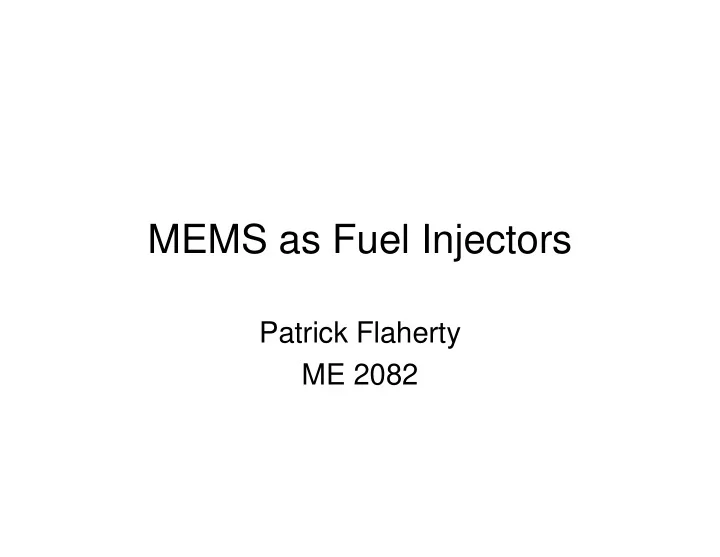

MEMS as Fuel Injectors Patrick Flaherty ME 2082
Why use MEMS as fuel injectors? • Quicker response time than conventional solenoid system • More accurate control of fuel, higher efficiency • Easier to obtain cleaner emissions, comply with emissions legislation
Emissions Control Legislation
MEMS as Fuel Injectors MEMS technology with potential as fuel injection systems: • Thermal Actuation • Electrostatic Actuation • Piezoelectric Actuation
Thermal Actuation • Technique is very similar to that utilized by thermal inkjet printer, well understood • Uses thermal energy to form a bubble inside a chamber, which acts as a pump to eject a droplet • Nozzle area atomizes the jet of liquid, increasing efficiency of combustion
Thermal Actuation Principles of operation: Driving Force − t = − + 0 . 5 P ( t ) ( P P ) exp( ) P τ v t s s Velocity: 1 ∫∫ + = mV P ( t ) dAdt mV 1 v 2 2 3 ∫ = V P ( t ) dt ρ 2 v 4 d d
Thermal Actuation ρ Penetration distance 1 = 1 . 5 d x 0 . 195 V d in air: ρ 2 v a a Temperature profile of diesel fuel: x t 1 ζ = = + − ξ − ζ ζ 2 exp( ) ( ) T T q erfc ∞ ρ α π k c 2 t d d p d σ 2 T Clausius-Clayperon = + sat T T ρ sat Equation: R h v fg
Thermal Actuation – Diesel Activiation Curve
Thermal Actuation - Application • Low penetration distance in air has not yet been improved. May be improved by airflow-assisted injection. • Diesel flashpoint of 71°C may cause combustion in actuator
Electrostatic Actuation • Uses double-acting diaphragm pump to inject fuel into the combustion chamber • Originally researched as a potential injection system for PDE, which requires a high degree of atomization • Requires less energy than thermal actuation, and is less temperature sensitive than piezoelectric actuation
Electrostatic Actuation
Electrostatic Actuation – Principles of Operation
Electrostatic Actuation – Principles of Operation Driving Force: µ 8 Lv µ ∆ = 12 Lv ∆ = P P (Hagen-Poiseuille) 2 R 2 h h = + F F F Total Force on e k Diaphragm: ε ε ε 1 2 2 V ( t ) 2 o r _ fuel r _ dielectric = F ( t ) [ ] 2 Electrostatic e ε − + ε ( G y ( t )) G fuel r _ fuel dielectric r _ dielectric Force: == F ( t ) k y ( t ) Spring Force: k s
Electrostatic Actuation - Application • Analytical models have been qualified using an inkjet type of test setup • Prototypes have been built, but experimental data has not yet been obtained • Fabrication may prove to be challenging
Piezoelectric Actuation • The only method that is currently being used in production engines (Denso, Siemens) • Simple, easily manufactured
Piezoelectric Actuation – Principles of Operation Piezoelectric material exhibits strain in the presence of an electric field:
Piezoelectric Actuation
Piezoelectric Actuation - Application • Rapid switch action, friction-free • More precise dosing than solenoid system • Improved atomization • Emissions reduced up to 20 percent
Summary • MEMS techniques (such as thermal and electrostatic actuation) continue to be researched as options for fuel injection • Piezoelectric actuation has been adapted successfully in diesel fuel injection systems • MEMS fuel injection, specifically piezoelectric, will probably be implemented in gasoline engines in the near future
Recommend
More recommend